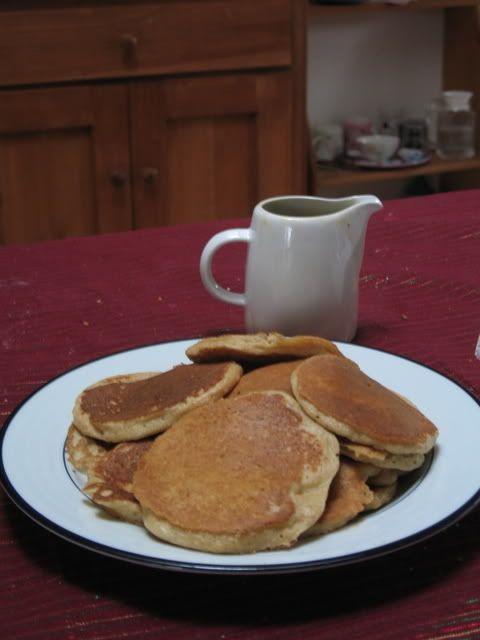Recently, I've been attempting to grind and sift my own flour. The grinding is straightforward with a Retsel Mil-Rite, an excellent home stone buhr mill or my new Meadows 8-inch stone mill. However, the mysteries of sifting the flour have been less straightforward. A subsequent blog entry will deal with my progress on grinding and sifting my own flour. The sifting project motivates the need for measuring the ash content of my flour.
Ash Content
Ash content in general is the percentage of inorganic matter in a sample of some material. It is used in many different ways to analyze agricultural products, at least, based on some cursory sampling of articles on the internet.
About.com says defines ash content as:
The nonvolatile inorganic matter of a compound which remains after subjecting it to a high decomposition temperature.
A traditional method for determining ash content is to place a sample of known weight in a furnace at high temperature (600F or higher) for a number of hours (12 hours, for example) such that all the water, volatile compounds, and organic matter either evaporate or burn. After that, the remaining material is weighed. Ash content is the weight of remaining "ash" expressed as a percentage of the original weight of the sample. The remaning mass will be the inorganic non-volatile compounds that were in the original sample.
Flour ash content in Europe is measured using a dessicated (dried out) sample of flour, so the original weight of the sample doesn't contain any water. In the US, a moisture content of 14% is assumed (typical for white flour before it is dried out), so US numbers for ash content differ from the same European measure by the amount of water in the original sample.
An Important Characterizing Measure of Wheat Flour
Ash content is widely used in Europe to classify flours. When you see "type 55", for example, the 55 refers to the ash content, which would be 0.55% of dry matter in this flour. In the US, it is often available by searching a manufacturer's or supplier's web site for flour specifications (often hidden somewhere hard to find), or more often, by calling someone in their testing department.
Why Ash Content
The inorganic matter in a wheat berry is heavily concentrated in the outer layers, such as the bran, various seed coatings, and the germ. As you traverse from the outer coatings to the outer endosperm and then to the inner endosperm, the concentration of inorganic matter steadily drops.
During milling, the flour is ground, then sifted, then ground again, and sifted again repeatedly. When the milling process is complete, a large number of bins of product will result from very coarse to very fine, and from very dark to very light flours. The whitest flours will have less ash content, and the darker flours will have more ash content. At this point, various grades of flour may be created by blending the flour from the bins.
Ash content then summarizes how much of the outer layers made it in to the final flour, regardless of how it may have been milled, sifted, and blended.
The importance of measuring ash content was immediately obvious to me as I tried to mill and sift at home on my own. An infinite number of possible permutations of grinding and milling could be imagined. For example, I tried grinding very coarsely, then sifting, then grinding the coarser results of the sifting again, then sifting again. Another version was grinding very finely and sifting into more and finer sizes. I also tried grinding coarsely, then regrinding, then sifting. Of course, the possibilities are endless. In each of these cases, flour resulted that made good bread, seemed light in color, and fine in texture. The difference to the eye and the feel in the hand was not great between one and the other, at least not to me, a first-time home miller.
Measuring ash content of my results would make it possible to know at least approximately how much of the outer layers had made it into each type of flour resulting from the various grinding and sifting processes tried. Also, once a given process is adopted and used consistently, calculating the right blend of the various outputs of the milling process to achieve a desired ash content, depending on the type of flour needed, should also be fairly easy.
The Theory
Distilled water doesn't conduct electricity. However, if some salt is dissolved in distilled water, it will conduct electricity. The ions contributed by the salt are charged particles that will travel through the water in the field created by the voltage difference on the electrodes of the conductivity meter to create a flow of electric current. The higher the concentration of salt, the higher the conductivity of the water and salt solution will be. The diverse mineral content in the inorganic matter that makes up the "ash content" of the flour ionizes the water in the same way described above for salt. If the flour has a larger amount of "ash content" it will also contribute a larger quantity of ionizing compounds to water, increasing the conductivity.
The Equipment
To measure conductivity you need a conductivity meter. In the field of water quality measurement, "Total Dissolved Solids" is a standard measurement, but it is essentially a measure of the conductivity of the water being tested. So, you can use either a "conductivity meter" or a "TDS Meter". In my case, I had obtained a Hanna 9813 pH meter a number of years ago, and it turns out it also had a conductivity meter function. However, it was easy to discover conductivity meters on the internet, by searching on terms like "Conductivity Meter", "TDS", "Total Dissolved Solids", "Water Quality Meter", and so on. One place I found was http://www.technika.com. Also searching on "Hannah Meter" might work, since that's the brand of meter I have that has both pH and conductivity meters, both useful functions for flour measurement.
You might wonder why a standard digital multi-meter wouldn't work. I tried to use one unsuccessfully. First of all, you would have to carefully mount the probes to maintain the same distance apart and total surface area exposed to the water. However, it gets worse. The DC current used by a digital multi-meter to measure resistance causes the ions to build up on the electrodes, so the measurement just goes higher and higher the longer you leave the electrodes in the water. Conductivity meters made for measuring water impurities use AC current to measure the conductivity so the above problem with an ohm-meter doesn't occur, have probes made of less reactive conductors, and are designed to maintain proper spacing of the electrodes.
The Method
I found a couple of papers on the internet describing methods of measuring ash content with conductivity. One was especially useful for home measurements and was titled, "Electrical Conductivity of Flour Suspensions and Extracts in Relation to Flour Ash." published in 1977 in the Journal of Cereal Chemistry. The method described below was derived from the discussion in this paper.
The method is very simple. Mix 100 grams of distilled water (should be distilled water to get good results) and add 5 grams of the flour to be tested in a container. Stir thoroughly to completely hydrate the flour. Periodically stir for about 12 hours. After the flour has settled to the bottom of the jar, measure the conductivity of the water. For the best measurement, allow the flour to settle on the bottom so there is clear water to measure. The clear water will have a higher conductivity than recently stirred and cloudy water. At first the conductivity rises, as the various compounds that contribute to the conductivity of the water dissolve, but at some point the conductivity will stabilize. In my case it took a long time, maybe 12 hours or so, for the conductivity to stop changing. The conductivity measured can then be calibrated by measuring flours with known ash content and fitting a curve of conductivity to the known ash content. In practice it looked very linear, so even a simple proportional relationship would give reasonable results, based on my admittedly minimal sampling.
| | ppm | uS/cm | ash % |
| hmap | 215 | 0.31 | 0.50 |
| home71 | 385 | 0.55 | 1.05 |
| hmgb | 420 | 0.60 | 1.13 |
| hmww | 470 | 0.67 | 1.70 |
| wrye | 530 | 0.76 | 1.90 |
The table above shows measured conductivity in ppm, as the meter represents it for TDS or "Total Dissolved Solids" in parts per million salts for a hydroponic solution and also shows conductivity in the more standard measure of milli-Siemens per cm. I don't know the ash content, but based on some flour specification information from Heartland Mill, I filled in rough numbers and then used them to approximate the ash content of my "71% yield, fairly white bread flour" sifted from a couple of passes with my new Meadows 8 inch mill and a couple of siftings with a number 60 sieve in my new SS-100 Econo-Shaker sieve shaker.
The method in the paper heated the samples to boil them for a short period, then cooled and centrifuged the samples to create a clear liquid with the dissolved minerals in it. I didn't want to deal with boiling or somehow obtaining a centrifuge. OK, maybe you could put your jars in bags, tie them to some rope and spin them like Argentine "bolas", but I recommend patience. It was unclear what the effects of boiling were from this paper, but it seemed to affect the measurement in some unexpected way. So, my approach is to keep it simple and just wait for the conductivity and the flour to settle, even if it takes a while.
Summary
You can obtain a reasonable estimate of ash content by mixing 5 grams of flour with 100 grams of distilled water, stirring periodically for a few hours and then measuring the stabilized conductivity and comparing to the same measurement for some reference flours of known ash content. I proceeded to make one of my favorite miche recipes and found this flour to give very comparable results to Heartland Mill Golden Buffalo flour, which is of similar ash content. The difference is I can mill my own version of the Golden Buffalo flour and obtain it absolutely fresh when called for. In addition, measuring and recording the ash content of the output from the various passes of grinding and sifting should allow me to blend the outputs in the right proportions to obtain a desired ash content for recipes that may call for more refined or less refined flour.




 WW loaf
WW loaf  WW bread, quick w/honey
WW bread, quick w/honey 



 Monogrammed sourdough: my first successful sourdough from my Cambridge kitchen yeast
Monogrammed sourdough: my first successful sourdough from my Cambridge kitchen yeast  Crusty brother boule: my monogrammed loaf's brother
Crusty brother boule: my monogrammed loaf's brother